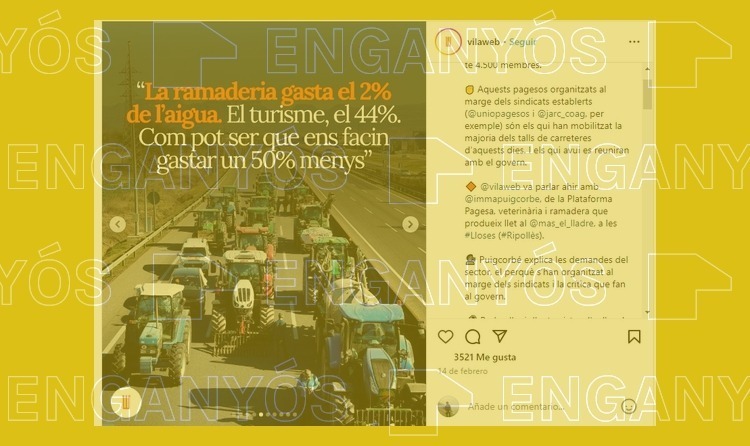Tourism does not consume 44% of the water in Catalonia

What has been said? That tourism consumes 44% of the water in Catalonia. What do …

What has been said?
That tourism consumes 44% of the water in Catalonia.
What do we know?
The figure of 44% refers to urban and household water consumption. The Catalan Water Agency (Agencia Catalana del Agua, or ACA) estimates the total consumption of the tourism industry at around 2%.
Via our WhatsApp channel, you’ve sent us a post with over 3,500 likes published by the VilaWeb Instagram account. In the post, Imma Puigcorbé, a veterinarian and member of Plataforma Pagesa, is quoted claiming that “the cattle industry uses 2% of the water” of Catalonia’s internal water basins, while tourism uses “44%” of it.
This claim is MISLEADING. While the amount of water consumed by the cattle industry coincides with the data from the Catalan Water Agency (ACA), the tourism figure is incorrect. Although there is no official data, the ACA’s estimates put the consumption of this sector at around 2% in its Management Plan for the River Basin District of Catalonia 2022-2027. When contacted by Verificat, Puigcorbé explained that the figure of 44% referred to urban and household water consumption, not to tourism.
“The cattle industry uses 2% of water. The tourism industry 44%.”
Imma Puigcorbé, veterinarian and Plataforma Pagesa member
As she explained to Verificat, Puigcorbé used the data published by the Catalan Water Agency as her source. In fact, the figure of 44% does not refer to tourism consumption, but rather to household and urban consumption of water derived from Catalonia’s internal basins. Meanwhile, 20% of that water is consumed by industry, and 36% by agriculture and the cattle industry, which constitutes 1.6% of the total water consumption, a figure that coincides with the one given by Puigcorbé.
As of the publication of this fact check, VilaWeb had not rectified its Instagram post. It has, however, rectified the entire interview on its website, after Verificat contacted the veterinarian and Plataforma Pagesa member. In the interview, it mentions that tourism consumes 12% of the water in the city of Barcelona, a figure published in Turisme I Metrópoli by Barcelona Regional.
Where did the 2% figure come from?
There is no official data on water consumption by the tourism sector in Catalonia as a whole. In the Management Plan for the River Basin District of Catalonia 2022-2027, the ACA estimated that the sector consumes around 22 cubic hectometres in the territory, a number that represents 2% of the total annual demand of the internal basins of Catalonia (1,043 cubic hectometres). Catalonia’s basins are divided into two categories: the internal river basins and the Ebro river basin. The agency warns, however, that “this evaluation must be understood as a preliminary estimate.”
The report brings together two different numbers to obtain the estimated water consumption as a result of tourism in Catalonia. The first, 8.5 cubic hectometres corresponds to the direct consumption by tourists or the non-resident population, which is to say, the water they have used for personal hygiene or cooking. These calculations were made based on estimates of the seasonal population, together with “other statistics related to the tourism sector”, such as the number of hotel beds and camping spots, the occupancy levels or the overnight stays.
The second figure comes from adding these 8.5 cubic hectometres to the 13 cubic hectometres that the leisure and tourism sector consumes every year in Catalonia. In any case, the plan does not take into account other uses associated with the sector, which might include the water needed to make the food that visitors eat or another “important part of the sector, which is tourist apartments”, David Saurí, professor of Geography at the Universitat Autònoma de Barcelona (UAB), explained to Verificat.
Hotels in Barcelona
In Barcelona, hotels consume between 8 and 12% of water, according to a 2016 study by Barcelona Regional, the city’s urban development agency, and another more recent one by the Barcelona Hotel Association. Water use per tourist has fallen over the years, according to a study that Saurí carried out during the drought of 2008, but this “does not mean that it is not a significant amount”, he concludes.
Despite these percentages, the Barcelona Metropolitan Area uses a fairly consistent amount of water throughout the year, according to the data submitted to the Management Plan, while the data of the Costa Brava Consortium shows spikes, especially in the months of July and August, due to the tourist season.